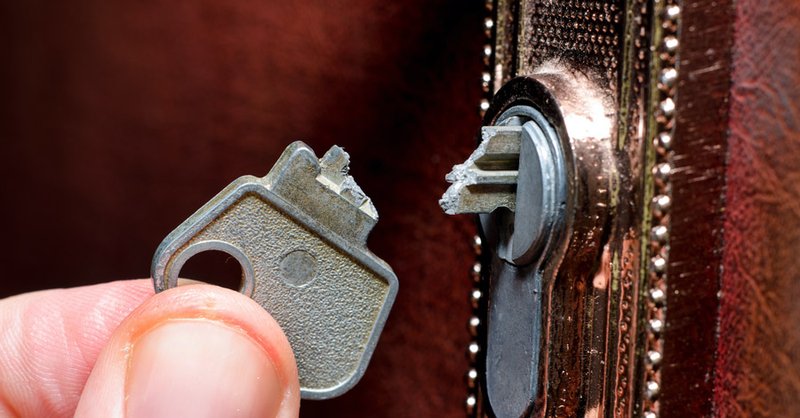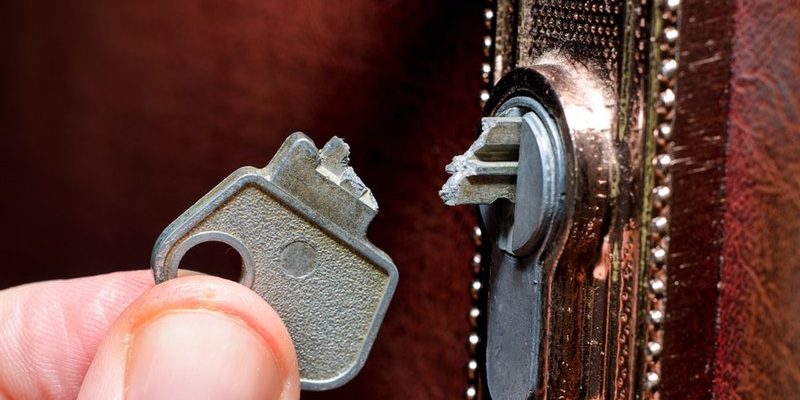
Honestly, keys shouldn’t just snap in two like brittle spaghetti. When it happens, it means there’s usually something else at play. Maybe it’s the way the lock turns lately, a stubborn latching, or even a tiny issue with your key itself. When you get down to it, a broken key in a handleset is your lock’s way of waving a red flag. Let me explain why this happens, what you can do, and how you can avoid it in the future.
Common Reasons Handleset Keys Break in the Lock
If you’ve ever had a key snap off in your lock, it’s not random bad luck—it’s usually the result of a few predictable issues. Most of the time, handleset keys break for a reason that’s been brewing behind the scenes.
Wear and tear is one of the top culprits. Think about how many times you use your key every week. Over time, all that twisting, pushing, and pulling puts stress on the metal. Keys start to develop tiny cracks or weak spots, especially if they’re made from soft metals like brass or nickel. Eventually, those small flaws add up, and the key breaks.
Another big issue is lock misalignment or damage. If your door or handleset isn’t aligned just right, it takes extra force to turn the key. Maybe the latch doesn’t retract smoothly, or you have to jiggle the key to get things working. That extra pressure doesn’t just make the key harder to turn—it actually bends the key each time. That repeated stress can snap even a good-quality key.
Let’s not forget debris or dirt inside the lock. Over the years, tiny pieces of lint, dust, or even old graphite lubricant can clog up the inside of your handleset lock. Suddenly, the internal pins don’t move freely, and you’re wrestling with your key just to get the door open. That’s a recipe for a broken key, especially if you’re in a rush or using a universal spare cut from a hardware store.
How Lock and Key Materials Affect Breakage
Here’s the thing: not all keys or locks are created equal. The metal your key is made from has a huge impact on how likely it is to snap off inside your handleset. Cheaper keys are often cut from soft metals like brass or a lightweight alloy, which can bend and break easily after heavy use.
Many high-end brands like Schlage or Yale use tougher materials, but even then, years of use can wear them down. If your handleset lock is a model designed for heavy-duty use, it might resist breakage a bit better. But if you’re using a duplicate key from a kiosk or hardware store, that key probably isn’t made to the same standards as the original. Dupes can have slightly rougher edges, weaker spots, or even tiny burrs that catch inside the lock.
The lock’s own metal also matters. A lock made with hardened steel internals will wear down keys faster than a lock with brass internals, just due to the difference in hardness. If you notice your keys wearing grooves, thinning, or developing sharp edges, that’s a red flag.
Always keep an eye on the condition of your keys—if you see visible wear, cracks, or warping, replace them before they break. It’s a lot easier than fishing a broken piece out of your lock!
Signs Your Handleset Lock Needs Maintenance
You might be wondering—how can you tell if your lock is crying out for help? The truth is, most handleset locks don’t suddenly break your key without warning. They give off little signals if you know where to look.
- Difficulty inserting or removing the key: If it feels sticky or gritty when you use your key, there could be debris or worn-out pins inside the lock.
- Needing to jiggle the key: Having to wiggle the key back and forth to get it to turn is a clear sign of misaligned pins or internal springs starting to fail.
- Feeling resistance when turning: If you have to use more force than usual, something inside the lock or handleset is obstructed. Don’t ignore this, even if your key and lock are from a reputable brand.
- Key gets warm or slightly bent: Metal warms up as you force it, and a bent key is one step away from snapping.
Over time, these little problems add up. If you catch them early, a quick cleaning or realignment can save both your lock and your keys—no emergency troubleshooting required.
What To Do If Your Key Breaks Off in the Handleset
So you’re standing at your door, half your key in your hand, maybe running late and starting to panic. What now? First, don’t force anything or try to jam another key in after it. That’ll just push the broken piece further in.
Let me walk you through a safe approach:
- Check the position: Is the broken key piece still accessible? If a bit of it is sticking out, you’re in luck.
- Use needle-nose pliers or tweezers: Gently grip the exposed end and pull straight out. Don’t twist—just pull.
- No luck? Try a key extractor: Locksmiths use thin tools that slide alongside the broken piece and hook it out. You can pick up a kit at most hardware stores, or make a small DIY tool from a thin jigsaw blade.
- Apply a light lubricant: Spray a small amount of lock lubricant (not WD-40!) into the cylinder. This helps the broken metal slide out more easily.
- If nothing works, call a locksmith: Sometimes the broken part is too deep, or you risk damaging the lock. A pro can remove it without ruining the handleset or the lock code.
Don’t try to use brute force or household objects like knives or paperclips. They almost always make things worse and can leave you needing a full lock replacement.
How to Prevent Your Handleset Key From Breaking
Here’s something most people overlook: a tiny bit of prevention can save a whole lot of headache. Regular lock maintenance is a lot like oil changes for your car. Ignore it too long, and things break down at the worst possible moment.
- Keep your lock clean: Every few months, spray a small amount of graphite or dry Teflon-based lubricant into the lock. Avoid oils—they attract dirt.
- Inspect your keys: Look for signs of wear. If your main key looks thinner, warped, or has visible cracks, get a replacement cut from the original code or a factory original—not a worn duplicate.
- Fix alignment problems: If you notice your door hangs low or the handleset seems off-center, get it adjusted. Misalignment is a huge stressor on both the lock and your keys.
- Don’t force stuck locks: If something feels wrong, don’t muscle through it. Try a spare key, reset the handleset if it’s digital, or do some gentle troubleshooting before you reach for the WD-40.
A lot of modern locks also allow for “re-keying” or code resets. If you’ve had issues with key breakage, consider syncing a new set of keys and resetting the lock cylinder to fit them.
When Should You Replace or Upgrade Your Handleset?
Sometimes, a broken key is just the tip of the iceberg. If your handleset lock has been giving you trouble more than once, it could be a sign that it’s time for an upgrade. Replacing an old, worn-out lock is often cheaper (and definitely less stressful) in the long run than dealing with emergency unlocks or damage to your door.
But when should you swap it out for a new one? Here’s what to watch for:
- Repeated key breakage: If you’ve snapped more than one key, the lock cylinder or pins are probably damaged.
- Visible damage or corrosion: Rust on the handleset or inside the keyhole is a sign that internal parts may be failing.
- Persistent issues after maintenance: Tried cleaning, lubricating, and adjusting but still have problems? It’s not worth fighting a losing battle.
- Security upgrades: Newer handlesets offer better protection against picking or bumping. If your current lock is more than 10 years old, consider upgrading for peace of mind.
Sometimes you don’t even need to replace the entire handleset—just re-keying the cylinder or switching to a smart lock (with code or remote options) can fix recurring problems. Compare universal fit models with brand-specific ones to make sure your upgrade fits your door and your needs.
Are Some Handleset Brands More Prone to Key Breakage?
You might be curious if certain brands or types of handlesets are more likely to break keys. The truth is, most major brands like Schlage, Kwikset, and Yale use sturdy materials and reliable lock designs. However, cheaper off-brand or “builder grade” handlesets often use softer metals or looser tolerances, making key breakage more likely.
That said, even high-end brands aren’t immune if the key or lock isn’t cared for. Universal fit handlesets that aim to “fit every door” sometimes have more moving parts, which can cause extra wear. If you use a universal remote key or a poorly duplicated key, you might see more breakage than if you stick to the brand’s original key.
In my experience, it’s less about the brand and more about how well the lock and keys are maintained and whether you use quality parts.
Choosing a reputable brand, syncing your lock and key correctly, and doing regular checkups will keep you from those unpleasant, time-wasting surprises.
How Weather and Environment Affect Key and Lock Health
People rarely think about how their local climate impacts their handleset and keys, but trust me, weather matters. Live somewhere humid or right on the coast? That salty, damp air creeps into every crevice, speeding up corrosion inside the lock and on your keys.
If you’re in an area with freezing winters, the cold can contract metal parts and make keys more likely to snap if you force them. Locks sometimes freeze up or collect condensation inside, which can gum up the works and require more force than usual to turn. This is a fast track to a snapped key, especially if you’re using a remote entry system and fall back on the physical key in a pinch.
Dusty or sandy places (think the Southwest) have their own problems. Fine particles work their way into the lock and function almost like sandpaper over time, slowly wearing away the delicate pin and key surfaces. Regular cleaning and using the right type of lubricant are key—literally—to avoiding a broken-off key in your handleset.
Wrapping Up: Keep Your Handleset (and Keys) Happy
Having your handleset key break off in the lock is a hassle, but it’s almost always preventable. Pay attention to the signals your lock sends—strange resistance, sticky turning, or wobbly alignment. Treat your keys and lock to a little regular cleaning, proper lubrication, and quick troubleshooting when things feel off.
If something goes wrong, don’t panic. Start with the simple solutions and call in a pro if you need to. And if you’re consistently running into trouble, consider upgrading to a better handleset or trying a smart lock system with remote or code entry—sometimes a little tech update saves you a world of frustration. Taking care of your door’s hardware might feel minor, but you’ll thank yourself every time you walk in (or out) without a hitch.
